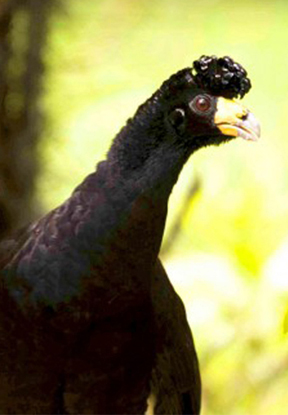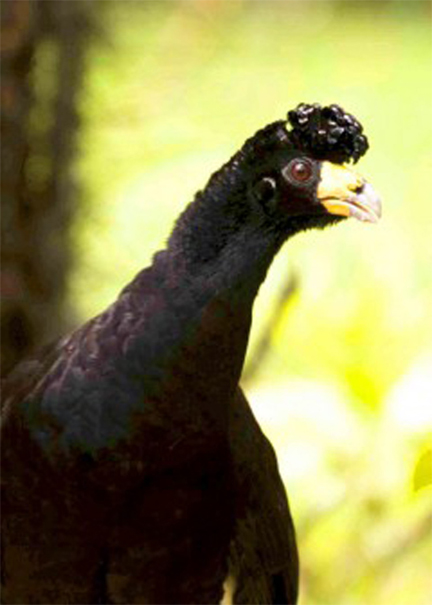The Black Curassow (Crax alector), or Powis, as they are locally called in Guyana, are found in humid forested areas in the Guianas, northern Amazon, southern Venezuela and parts of Colombia, and are part of the family of game birds known as Cracidae. This glossy, black, chicken-like bird is easily identified by its curly upswept ‘hairdo’ and bright yellow beak.

![]() Powis are shy but are often seen foraging on the ground for fruits, seeds and young leaves on the edges of forest roads. They are important for dispersing seeds and tend to be found in pairs, or in small groups with young chicks.
Powis are shy but are often seen foraging on the ground for fruits, seeds and young leaves on the edges of forest roads. They are important for dispersing seeds and tend to be found in pairs, or in small groups with young chicks.
Their call, a low booming “umm um…umm um umm” sound, is most commonly heard during early mornings and evenings and is a typical forest sound. They prefer to walk, but will fly with swooping hops into the trees to sleep or to escape predators with the “click” of an alarm call.
Amerindians use the Powis flight feathers to fletch their arrows, and their large size (an adult weighs about 2.8 kg), makes them a target food resource. Unfortunately, Cracids are considered to be one of the most endangered family of birds in the Americas due to overhunting and habitat loss, with some species few in number or now extinct in the wild. Fortunately however, Powis seem to be managing well in Guyana and are not currently endangered. Due to their shyness and preference for undisturbed forest, a healthy population of Powis indicates a healthy ecosystem and environment.
Early in the morning, two family groups of Powis can be commonly seen at the base of Iwokrama’s Canopy Walkway as they patrol their territory and hunt for food.
Rain forests are rich in biodiversity and are home to many different plants and animals as well as indigenous communities. Humans, even those who don’t live in the rain forest, rely on it for resources such as building materials (wood and lianas), medicine and fruits.
Rain forests also provide essential environmental services for life on earth; they create soil as well as prevent soil erosion, produce oxygen though photosynthesis, maintain clean water systems, and are a key defence against climate change.
The Iwokrama Rain Forest is 371,000 hectares, located in the heart of Guyana. Our mission is to develop strategies for conservation and sustainable development for local people in Guyana and the world at large. We are involved in timber, tourism and training. Come and visit us in the rain forest or at http://www .iwokrama.org.
(First published February 13, 2011)

